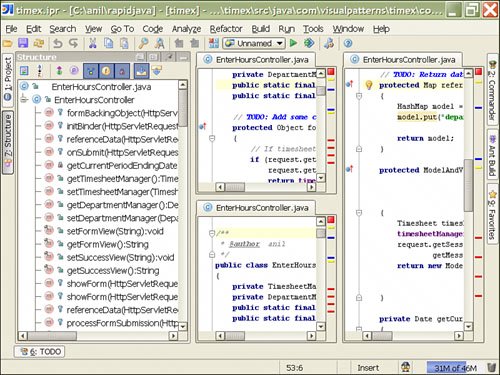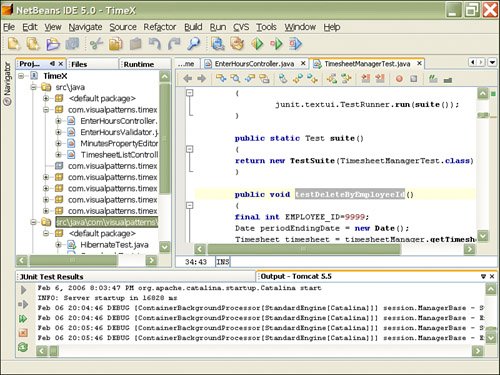An Unfair Comparison to IntelliJ and NetBeans
| The two other popular Java IDEs include JetBrain's IntelliJ and Sun Microsystem's NetBeans. I decided to install each and give them each about 30 minutes, just to see how quickly I could get up and running with these IDEs compared to Eclipse. Note Disclaimer: Let me state explicitly that my opinions here are extremely biased toward Eclipse, given everything I have mentioned so far in this chapter. So, I'm not entirely sure how much value this section adds because it is somewhat unfair to judge a product in 30 minutes or less. However, I was hoping to get some first impressions and also to see how I could re-create a project for Time Expression in other IDEs. IntelliJ 5.0First, I decided to try out JetBrain's IntelliJ 5.0 because I had heard so much from several people about IntelliJ being a wonderful product. The IntelliJ download was very quick and the installation went smoothly. However, the startup wasn't. For some reason, IntelliJ wanted to act as a server and my firewall program detects that. It took me a while to figure out how to set up a project. The setup of Tomcat was also not user friendly. Even the JDK setup was somewhat manual. Overall, I found IntelliJ's interface slick, but confusing and slower than Eclipse. Figure 8.52 shows a screenshot of the Time Expression files in IntelliJ. I did like the split window feature, which allows you see the same file in multiple windows, similar to Microsoft Word's Window, Split feature, but more powerful. Again, my opinions are extremely biased toward Eclipse and all I can give you here are first impressions. Figure 8.52. JetBrain's IntelliJ 5.0. NetBeans 5.0Next, I decided to install Sun Microsystem's NetBeans 5.0. The install was very straightforward. I was also able to create a project for Time Expression from an existing build.xml file, just like Eclipse does. The integration with Tomcat was also very tight and smoothin fact, slightly better than Eclipse. There was even a bundled version of Tomcat, but I added a server in NetBeans, which allowed me to point to the existing install. Given this, I was able to start up Tomcat immediately after configuring it and timex.war was deployed in NetBeans (see Figure 8.53). I was also able to test my JUnit code instantly with a single configuration. Figure 8.53. Sun Microsystem's NetBeans 5.0. I must say that NetBeans is also a very well done IDE and the overall download, install, build, unit test, and deploy app took under 30 minutes and without reading any online help! Overall, it was fun to use this IDE; there was something very enjoyable and elegant about it, possibly because everything worked the first time. Even though NetBeans was set up faster and is a very well-designed IDE, the sheer number of plug-ins available for Eclipse and the community and marketplace behind it make Eclipse a clear winner and NetBeans a close second. At the time of this writing, there were more than 1,075 plug-ins on one of the Eclipse directories I mentioned earlier, whereas the NetBeans site listed 46 plug-ins. Also, when I did a search on google.com for the words "netbeans" and "plugin" (or "plug-in"), I got fewer than, 500,000 hits; as I had mentioned in the beginning of this chapter, I got millions of hits for Eclipse! Startup TimesI could see that the Eclipse SDK startup time was faster, but I wanted to get some real test numbers on thisnothing too formal or extensive, just the number of seconds it took for each IDE to start and have the Time Expression project loaded and available. I rebooted my PC to ensure that none of the IDE executables were cached in memory to give it a leg up on the others. The startup times for each IDE were as follows:
Incidentally, I used an Intel Pentium M processor 750 based machine (1.86GHz/2MB Cache/533MHz FSB) with 1GB of shared memory (DDR2, 533MHZ) running Microsoft Windows XP Media Center Edition 2005. Also, the startup time shown for Eclipse here included all the plug-ins we covered in this chapter (without some or all of these plug-ins, the startup time would presumably have been faster). Again, my views are biased; however, these numbers are not fudged. In fact, I rebooted my machine three times for various reasons to ensure that I was giving each IDE a fair trial. You may want to conduct similar tests if you are evaluating IDEs and have not made up your mind. |
EAN: 2147483647
Pages: 219
- Using SQL Data Definition Language (DDL) to Create Data Tables and Other Database Objects
- Understanding SQL Transactions and Transaction Logs
- Performing Multiple-table Queries and Creating SQL Data Views
- Working with Comparison Predicates and Grouped Queries
- Monitoring and Enhancing MS-SQL Server Performance